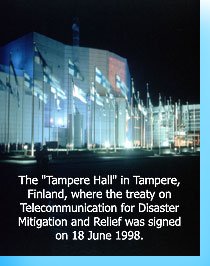A Life-Saving Treaty

| When disaster strikes, communication links are often disrupted. These links are essential, especially for relief workers who arrive on the scene. People affected by disasters will now be able to benefit from faster and more effective rescue operations, thanks to the Tampere Convention on the Provision of Telecommunication Resources for Disaster Mitigation and Relief Operations that came into force 8 January 2005, following the ratification by 49 countries. Until now, the trans-border use of telecommunication equipment by humanitarian organizations is often impeded by regulatory barriers that make it extremely difficult to import and rapidly deploy telecommunications equipment for emergency without prior consent of the local authorities. The treaty simplifies the use of life-saving telecommunication equipment.
|
The Tampere Convention calls on States to facilitate the provision of prompt telecommunication assistance to mitigate the impact of a disaster, and covers both the installation and operation of reliable, flexible telecommunication services. Regulatory barriers that impede the use of telecommunication resources for disasters are waived. These barriers include the licensing requirements to use allocated frequencies, restrictions on the import of telecommunication equipment, as well as limitations on the movement of humanitarian teams.
The Convention describes the procedures for request and provision of telecommunication assistance, recognizing the right of a State to direct, control and coordinate assistance provided under the Convention within its territory. It defines specific elements and aspects of the provision of telecommunication assistance, such as termination of assistance. It requires States to make an inventory of the resources – both human and material – available for disaster mitigation and relief, and to develop a telecommunication action plan that identifies the steps necessary to deploy those resources.
ITU, as requested by the Operational Coordinator (the United Nations Emergency Relief Coordinator), will assist in fulfilling the objectives of the Tampere Convention. This life-saving international treaty was unanimously adopted on 18 June 1998 by the delegates of the 75 countries that attended the Intergovernmental Conference on Emergency Telecommunications (ICET-98).
The Tampere Convention was ratified
by Cape Verde on 22 March 2018, bringing a total of 49
ratifications. Another 31 parties sign the convention but have not yet
ratified. The list of States signed/ratified the Tampere Convention
is available at the
United Nations Treaty Collection (UNTC) website.
Introduction slides Tampere Convention – Ratification and Implementation are available in English, French, and Spanish.